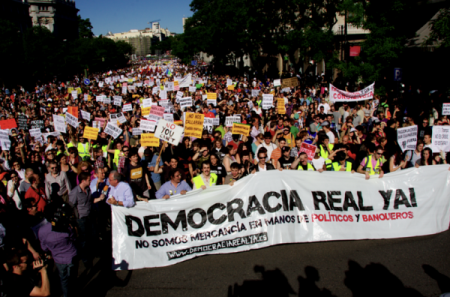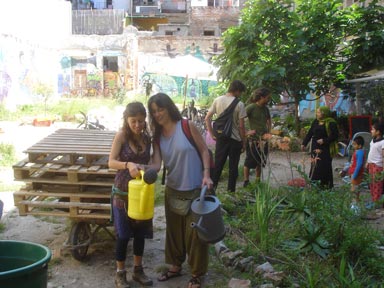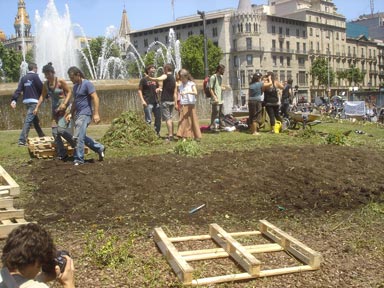Vermont governor signs single payer bill
Etiquetas: eng, Health Care, Single Payer, Vermont
Blogueando desde marzo de 2004 / Blogging since March 2004. Creador también de The World According to Carmelo: carmeloruiz.tumblr.com. Contacto: ruiz@tutanota.com. Twitter: @carmeloruiz
Etiquetas: eng, Health Care, Single Payer, Vermont
Etiquetas: Chris Lang, Comercio de Carbono, esp, REDD
Murray developed social ecology in the postwar era, when moving the social agenda forward in a radical way seemed possible. Utopianism, he said, not only possible but necessary. Today it may still be necessary, but it seems very far from possible. The champions of antistatism today are Wall Street, gigantic financial institutions, multinational corporations. The Koch Brothers are the great success story of American libertarianism, champing at the bit to undo the social safety net that progressive people in the twentieth century struggled to create. (Other forces subservient to capital are cutting social programs in Europe and the U.K.) In the coming months the Republicans in Congress are going to put Medicaid and Medicare on the chopping block. Many real people—not theoretical people in the pages of theoretical articles, but real people–are suffering now from the untrammeled financial royalism of Wall Street and will suffer more when they lose the social programs. I fail to see how an antistatist practice can address this ominous situation constructively. What does make sense to me, mundane as you may think it, is a rearguard fight to preserve the social programs. So no, I will not form a study group to smash the state; I will march to defend Medicare and Medicaid. I am not an antistatist—be it anarchist, communalist, or social ecologist; I am a social democrat and make no apologies for it.
Etiquetas: Biehl, eng, Social Ecology
"Tres estudios científicos recientes vuelven a poner en cuestión la seguridad para la salud de los alimentos transgénicos. Amigos de la Tierra exige al Gobierno la prohibición del cultivo e importación de transgénicos en España, y estudios independientes para evaluar la presencia de estas toxinas en la población española."
Tres estudios científicos recientes vuelven a poner en cuestión la seguridad para la salud de los alimentos transgénicos. Investigadores del Hospital Universitario Sherbrook en Quebec, han encontrado presencia de toxinas producidas por cultivos transgénicos en sangre de mujeres embarazadas y fetos. Por otro lado, científicos portugueses y españoles alertan en sendas publicaciones del grave conflicto de intereses en la investigación sobre riesgos de los transgénicos para la salud. Amigos de la Tierra exige al Gobierno la prohibición del cultivo e importación de transgénicos en España, y estudios independientes para evaluar la presencia de estas toxinas en la población española.
El estudio realizado en el Hospital Universitario de Quebec, publicado por la revista científica Reproductive Toxicology, analizó muestras de sangre de mujeres embarazadas, de cordones umbilicales y de mujeres no embarazadas. Los resultados muestran que la proteína tóxica insecticida Bt Cry1Ab estaba presente en el 93% de las mujeres embarazadas, el 80% de los cordones umbilicales y el 67% de las mujeres no embarazadas. La fuente más probable de esta presencia es el consumo de alimentos transgénicos. Aunque, los científicos no han especulado sobre los efectos que esto podría tener para la salud, al no ser el objetivo de su estudio.
“Este estudio muestra que las proteínas Bt procedentes de los cultivos transgénicos sobreviven en el sistema digestivo y pasan a la sangre, algo que las autoridades siempre habían afirmado que no ocurriría. Los resultados cuestionan la validez del proceso de evaluación de estos alimentos y son un ejemplo más de los efectos inesperados y preocupantes que generan los alimentos modificados genéticamente. Necesitamos aplicar el principio de precaución, prohibiendo tanto el cultivo como la importación de alimentos transgénicos”, afirmó David Sánchez, responsable de Agricultura y Alimentación de Amigos de la Tierra.
Otro estudio publicado por investigadores de la Universidad de Oporto en Food Policy, la principal revista científica en el campo de la economía y política agraria, muestra la preocupante relación entre la financiación y los resultados en los estudios sobre riesgos para la salud de los transgénicos. Los resultados confirman la estrecha relación entre quién financia o para quién trabajan los científicos y los resultados favorables para la seguridad de los transgénicos. En la misma línea apunta un artículo publicado recientemente por el Catedrático de Toxicología de la Universidad Rovira i Virgil, José L. Domingo, al realizar una revisión de los artículos publicados sobre riesgos toxicológicos de los transgénicos. En el artículo se aprecia un equilibrio entre los estudios que demuestran la seguridad de los alimentos transgénicos frente a los que detectan posibles riesgos, confirmando también que aquellos que demuestran su seguridad son realizados en su mayoría por la industria.
España es el único país de la UE que cultiva transgénicos a gran escala. En 2010 se cultivaron en torno a las 67.000 hectáreas del maíz transgénico MON810, modificado para producir la toxina insecticida Bt destacada en el estudio canadiense. Mientras, países como Austria, Francia, Alemania, Hungría, Italia o Luxemburgo prohíben su cultivo por sus incertidumbres para la salud, sus impactos ambientales y la imposibilidad de evitar la contaminación genética de los cultivos convencionales y ecológicos. El propio Comisario de Agricultura de la UE, Dacian Ciolos, afirmaba recientemente que la agricultura europea no debería estar basada en la producción de alimentos baratos a cualquier coste y que los transgénicos no cumplen con la calidad que exigen las personas consumidoras.
“Exigimos al Gobierno que promueva estudios independientes para evaluar la presencia de esta toxina en la población española y los posibles efectos para la salud. La complicidad del Ministerio de Medio Ambiente con la industria de los transgénicos nos expone a un riesgo inaceptable, no hay motivos que justifiquen la presencia de transgénicos en nuestra agricultura y en nuestra alimentación”, añadió Sánchez.
Fuente: Amigos de la Tierra
Etiquetas: esp, Esther Vivas
By HARVEY WASSERMAN
New readings show levels of radioisotopes found up to 30 kilometers offshore from the on-going crisis at Fukushima are ten times higher than those measured in the Baltic and Black Seas during Chernobyl.
"When it comes to the oceans, says Ken Buesseler, a chemical oceonographer at the Woods Hole Oceanographic Institution, "the impact of Fukushima exceeds Chernobyl."
The news comes amidst a tsunami of devastating revelations about the Fukushima disaster and the crumbling future of atomic power, along with a critical Senate funding vote today:
Fukushima's owner, the Tokyo Electric Power Company, has confirmed that fuel at Unit One melted BEFORE the arrival of the March 11 tsunami.
This critical revelation confirms that the early stages of that melt-down were set in motion by the earthquake that sent tremors into Japan from a relatively far distance out to sea.
Virtually all of Japan's 55 reactors sit on or near earthquake faults. A 2007 earthquake forced seven reactors to shut at Kashiwazaki. Japan has ordered shut at least two more at Hamaoka because of their seismic vulnerability.
Numerous reactors in the United States sit on or near major earthquake faults. Two each at Diablo Canyon and San Onofre, California, are within three miles of major fault lines. So is Indian Point, less than 40 miles from Manhattan. Millions of people live within 50 miles of both San Onofre and Indian Point.
On January 31, 1986, the Perry reactor, 35 miles east of Cleveland on Lake Erie, was damaged by an earthquake rated between 5.0 and 5.5 on the Richter Scale---orders of magnitude weaker than the one that struck Fukushima, and that could hit the sites in California, New York and elsewhere around the globe.
TEPCO has confirmed that at least three of the Fukushima reactors---Units One, Two and Three---have suffered at least partial fuel melts. In at least one case, the fuel has melted through part of the inner containment system, with molten radioactive metal melting through to the reactor floor. A wide range of sources confirm the likelihood that fission may still be proceeding in at least one Fukushima core. The danger level is disputed. But it clearly requires still more commitment to some kind of cooling regime that will send vast quantities of water into ocean.
At least one spent fuel pool---in Unit Four---may have been entirely exposed to air and caught fire. Reactor fuel cladding is made with a zirconium alloy that ignites when uncovered, emitting very large quantities of radiation. The high level radioactive waste pool in Unit Four may no longer be burning, though it may still be general. Some Fukushima fuel pools (like many in the United States) are perched high in the air, making their vulnerability remains a serious concern. But a new report by Robert Alvarez indicates the problem in the US may be more serious that generally believed.
Unit Four is tilting and may be sinking, with potentially devastating consequences. At least three explosions at the site have weakened critical structures there. Massive leakages may have softened the earth and undermined some of the buildings' foundations. Further explosions or aftershocks---or a fresh earthquake---could bring on structural collapses with catastrophic fallout.
TEPCO has now confirmed that there are numerous holes in the containment covering Unit Two, and at least one at Unit One. The global nuclear industry has long argued that containments are virtually impenetrable. The domes at Fukushima are of very similar design and strength as many in the US.
The health impacts on workers at Fukushima are certain to be devastating.
After Chernobyl, the Soviet government sent more than 800,000 draftees through the seething wreckage. Many stayed a matter of 90 seconds or less, running in to perform a menial task and then running out as quickly as possible.
Despite their brief exposure, these "liquidators" have suffered an epidemic of health effects, with an escalating death toll. Angry and embittered, they played a significant role in bringing down the Soviet Union that doomed them.
At Fukushima, a core of several hundred workers essentially sacrificed themselves in the early stages of the disaster. They courageously entered highly contaminated areas to perform tasks that almost certainly prevented an even worse catastrophe.
David Brenner, the director of the Center for Radiological Research at Columbia University Medical Center, said of the workers: "Those are pretty brave people. There are going to be some martyrs among them'."
"I don't know of any other way to say it, but this is like suicide fighters in a war," said University of Tokyo radiology professor Keiichi Nakaga.
Unfortunately, the toll among Fukushima's workers is certain to escalate. As few as two in five being sent into the Fukushima complex are being monitored for radiation exposure. According the Mainichi Shimbun, just 1,400 workers at Fukushima had been given thorough checkups, with just 40 getting their results confirmed.
Even at that, Japanese officials have raised the allowable dosages for nuclear workers from 100 millisieverts to 250, five times what's allowed for US workers, and 125 times what reactor workers typically receive in a year.
Some 88% of Japan's reactor work force are part-timers, sparsely trained and often paid extra money to race into highly radioactive areas and then run out.
But Nobuaki Terasaka, head of the Nuclear and Industrial Safety Agency, May 16 confirmed some 4,956 cases of internal exposure to radiation among workers at reactors around the country. Of those, 4,766 were originally from Fukushima and had moved to other sites, but had re-visited the prefecture after the 3/11 disaster.
Some of the stricken workers believe they were contaminated when they returned home for their families, even though they may have stayed only briefly.
Workers at Fukushima itself report spotty testing and dangerous facilities, including a leaky earthquake-resistant building where they took their breaks. "We had our meals there, so I think radioactive substances came into our bodies," says one male worker. "We just drink beer and wash them down."
A "dead zone" around Fukushima similar to the one surrounding Chernobyl is likely in the making. According to a report published in the Japan Times, levels of contamination in areas around Fukushima are at least comparable to some around Chernobyl.
But people outside the official evacuation zone are also vulnerable. Radiation detected in Tokyo, nearly 200 miles away, at one point prompted the Japanese government to recommend mothers not use tap water to mix formula for their infants.
Nonetheless children have been observed attending schools while bulldozers were removing the radioactive soil from their playgrounds outside. Amidst global protests, the Japanese government has weakened the limits of allowable radiation exposures to children.
In the midst of the disaster, the owners of the Indian Point reactors have announced their refusal to upgrade fire protection systems which New York Attorney-General Eric Schneiderman says are "."
More than 70% of the plant remains unprotected, he says, a "reckless" practice. Schneiderman accuses federal regulators as being too cozy with the plant's owners. Schneiderman and New York Governor Andrew Cuomo want the two IP reactors shut.
Over the weekend only four of Germany's seventeen reactors were operating, but the country suffered no apparent energy shortages. Prime Minister Angela Merkel has ordered seven older reactors shut, and the rest to be closed by 2011. But six of the newer ten closed for various technical reasons.
More than 20,000 Swiss citizens rallied to demand an end to plans to build new reactors there. The Swiss government has now confirmed it will not build new reactors, another major blow to the industry, this time resulting in the cancellation of plans for at least three projects.
Japan is standing by its decision to build no more reactors, while China has put some 28 proposed projects on hold. China's reaction to Fukushima will be crucial to the future of nuclear power, as it is by far the largest potential market for new reactors. Though prevailing winds head the other way, Fukushima is relatively close to China, and some fallout has been detected there.
The Obama Administration has still produced no comprehensive monitoring of radioactive fallout coming to the United States and has provided no guidance as to how American citizens can protect themselves, except to say not to worry. Polls now show more Americans opposing new reactors than favoring them, and grassroots opposition is fierce.
But the industry is pushing ahead with demands for $36 billion in loan guarantees for new reactors, with a preliminary vote expected soon in a House Appropriations Subcommittee. Nuclear opponents are asked to call the White House and Congress steadily through the 2012 budget process.
Also, today (May 26) may see a vote in a Senate committee on a CEDA plan that would provide still more money for new nukes. Safe energy advocates are urged to call their Senators asap.
The International Atomic Energy Agency of the United Nations, has announced it sees no health effects at Fukushima. The pronouncement comes as no surprise from an agency whose mandate is focused on promoting atomic energy.
The IAEA has consistently low-balled death toll estimates at Chernobyl and regularly ignores industry critics. The pronouncement comes as the agency begins a long-term study of Fukushima's health effects. Meanwhile, a French watchdog agency has urged that 70,000 more people be evacuated from the Fukushima area. Coming from France, among the world's pro-nuclear nations, the warning is a grim reminded of how deadly the contamination surrounding Fukushima must be.
But for all the focus on land-based contamination, the continuing flood of radioactive materials into the ocean at Fukushima could have the most problematic long-term impacts. Long-term studies of radiological impacts on the seas are few and far between. Though some heavy isotopes may drop to the sea bottom, others could travel long distances through their lengthy half-lives. Some also worry that those contaminants that do fall to the bottom could be washed back on land by future tsunamis.
Tokyo Electric has now admitted that on May 10-11, at least 250 tons of radioactive liquid leaked into the sea from a pit near the intake at Unit 3, whose fuel was spiked with plutonium. According to the Japanese government, the leak contained about 100 times the annual allowable contamination.
About 500 tons leaked from Unit 2 from April 1 to April 6. Other leaks have been steady and virtually impossible to trace. "After Chernobyl, fallout was measured," says Buesseler, "from as far afield as the north Pacific Ocean."
A quarter-century later the international community is still trying to install a massive, hugely expensive containment structure to suppress further radiation releases in the wake of Chernobyl's explosion.
Such a containment would be extremely difficult to sustain at seaside Fukushima, which is still vulnerable to earthquakes and tsunamis. To be of any real use, all six reactors and all seven spent fuel pools would have to be covered.
But avenues to the sea would also have to be contained. Fukushima is much closer to the ocean than Chernobyl, so more intense contamination might be expected. But the high radiation levels being measured indicate Fukushima's most important impacts may be on marine life.
The US has ceased measuring contamination in Pacific seafood. But for centuries to come, at least some radioactive materials dumped into the sea at Fukushima will find their way into the creatures of the sea and the humans that depend on them.
Harvey Wasserman, a co-founder of Musicians United for Safe Energy, is editing the nukefree.org web site. He is the author of SOLARTOPIA! Our Green-Powered Earth, A.D. 2030, is at www.solartopia.org. He can be reached at: Windhw@aol.com
Etiquetas: Counterpunch, eng, Nuclear, Wasserman
25 mayo, 2011 por fuspey
It has been truly incredible to witness the Democracia Real Ya! (Real Democracy Now!) movement explode all over Spain over the last week, and even more exciting to participate in these days where the whole idea of “Democracy” is being completely re-examined and re-constructed. In streets, squares and parks all over Spain people are asking themselves what sort of world do they want and how are they going to create it. In fact, the simple yet truly powerful gesture is being replicated right the way around this planet at present. Strange and amazing days to be alive, YA!
Must Reads: From Arab Spring to Spanish Summer: The Protests Continue | Notes from Barcelona’s Tahrir Square | Spain’s Tahrir Square | Spain’s impossible realists (Guardian) | The #Spanish Revolution (El Pais) | Infos: Tahrir > Spain > World | Tahrir comes to Spain | #spanishrevolution goes global | LIVE STREAMS: Madrid 1 2 3 4 (11+ million views in few days) | Barcelona 1 2 | Valencia | Alacante | Tarrassa | Murcia | Valladolid | Sevilla
 Democracia Real Ya! (Real Democracy Now!)
Democracia Real Ya! (Real Democracy Now!)
 Democracy in action @ Placa Catalunya: via @acampadabcn
Democracy in action @ Placa Catalunya: via @acampadabcn
 Wiggling hands means “I agree” at @acampadaBCN
Wiggling hands means “I agree” at @acampadaBCN
Etiquetas: eng, España, Europa, Protest, Spain, Union Europea
Etiquetas: eng


...y transportar por las calles del centro de Barcelona con una carretilla y un carro de la compra.
 Otro grupo se fue a Can Masdeu a buscar, paja y planteles....Cuando regresamos a la plaza ya había una colla de gente que había empezado a preparar el terreno, lo cual nos sorprendío bastante.....pero bueno.
Otro grupo se fue a Can Masdeu a buscar, paja y planteles....Cuando regresamos a la plaza ya había una colla de gente que había empezado a preparar el terreno, lo cual nos sorprendío bastante.....pero bueno.
Etiquetas: Barcelona, esp, España, Permacultura, Union Europea
| Organic agriculture a good option for LDCs At the recent Fourth United Nations Conference on Least Developed Countries, the UN Conference on Trade and Development (UNCTAD) and the UN Environment Programme (UNEP) launched their short film on “Organic Agriculture: A Good Option for LDCs” at the High-Level Interactive Thematic Debate on “Reducing Vulnerabilities, Responding to Emerging Challenges, and Enhancing Food Security in the LDCs”. In tandem, an UNCTAD policy brief on “Sustainable Agriculture and Food Security in LDCs” calls for a “fundamental transformation, even a revolution, in agriculture”, in order to address the problems faced by in the rural areas of the LDCs. This transformation should not be based on expensive, imported external inputs, as going down the high-external- input-dependent, industrial agriculture route places LDCs in a situation of extreme vulnerability. UNCTAD asserts instead that the transformation should be based on sustainable agriculture, which focuses on ecological, and not chemical intensification of agricultural production. The policy brief highlights research by the UN and numerous other bodies, which demonstrates that sustainable agriculture improves food supply, nutrition and livelihoods in LDCs. It also provides recommendations for policy makers. The film and policy brief are available at: With best wishes, Lim Li Ching
Least Developed Countries Series Sustainable Agriculture and Food Security in LDCs The most critical issues facing LDCs today are poverty and hunger. These issues related to each other and to environmental degradation. LDCs are primarily agricultural economies with nearly 70% of the population engaged in agriculture. The vast majority of the poor and food insecure are in rural areas. Therefore poverty alleviation and food security must start in these areas. TO READ THE REST OF THE ARTICLE: http://www.twnside.org.sg/title2/susagri/2011/susagri163.htm |
Etiquetas: eng, Lim Li Ching, Organic, Third World Network, TWN
In Wisconsin we saw a return to the streets, young and old protesting side by side. The philosophies and techniques deployed by organizers there exposed the right’s assault on unions and progressive institutions that have made Wisconsin great. Carl Gibson, co-founder of US Uncut, a decentralized grassroots movement inspired by Johann Hari's reporting in The Nation, wants to see a return to a culture of protest. “All you need is a laptop, a cell phone and five friends,” says Gibson on how to start a local chapter of US Uncut, which exposes corporate tax cheats and resists unfair public service cuts. He does, however, believe that more tools are needed to sustain the movement. So, combining the Uncut organizing model with the philosophy of Gene Sharp (The Albert Einstein Institution), whose ideas helped inspire the revolutionaries who toppled Hosni Mubarak’s dictatorship in Egypt, here are ten things to start and sustain a movement built on the spirit of Wisconsin. To learn more about the current state of Wisconsin, read Anne McClintock’s analysis and John Nichols’s reporting.
1 Before you start rallying in the street, understand exactly what you are fighting for or against, so you can plan the best method of protest. Read Gene Sharp’s Self-Liberation: A Guide to Strategic Planning for Action to End a Dictatorship or Other Oppression. Use the tools on US Uncut to get started.
2 Learn about the situation we are in now. Read Nicholas Shaxson's Treasure Islands: Uncovering the Damage of Offshore Banking and Tax Havens (treasureislands.org). Read Walter Mosley’s Twelve Steps Toward Political Revelation.
3 Don’t be a slave to technology. Social media should be only one of many communication tools. Connect online and on-land strategies to make sure they augment each other. Allison Fine, a senior fellow at Demos, writes about the intersection of social media and social change. Go to her blog, allisonfine.com, for advice and updates on using technology effectively.
4 Find five friends who are media savvy, technologically savvy, camera savvy, research savvy and local-organization savvy. Check out the organizing tools on Wellstone for advice on building an action plan.
5 Remember that police officers are part of the status quo you are rebelling against, so they may consider your protest threatening. Know your rights. Read ACLU's guide on civil disobedience.
6 Be creative about your planned action. You don’t have to stage a full-blown protest to make a difference. Every time someone speaks out in a Bank of America, they have to report it. Imagine what would happen if they got 100 individual protests in one day! To get inspiration for more creative action, go to Yes Lab, the site of the Yes Men, who target "leaders and big corporations who put profits ahead of everything else." Go to US Uncut's website to publicize your action.
7 Learn how to leverage social media stories to connect with the mainstream. Tape and photograph your protest and send it to your local media. To find the right outlet go to Newspapers.com and Spark Action. US Uncut invites you to send pictures and videos of your action. Learn how to talk to interviewers. Go to “Other Resources.”
8 Keep the momentum going. Start a website or a blog and update it regularly.
9 Link with other organizations. Share ideas and attend leadership-building workshops. Go to People For The American Way or Sojustlead.org to check out training workshops. Communicate and assist other regional actions. Work with your state’s Citizen Action group and check out the ones in New York and Wisconsin.
10 All of us can’t organize or participate in protest all the time. But there are alternatives. Read Gene Sharp's The Politics of Nonviolent Action for 198 specific alternatives. Support the Stop Tax Haven Abuse Act. Support the Move Your Money Project to end the monopoly that too-big-to-fail banks have on the economy.
Other Things: Check out Showdown in America's latest action where they storm the 'Chase' castle! Go to National People's Action for training ideas and to join their network in your state.
Conceived by Walter Mosley, with research by Rae Gomes
"Ten Things" is a monthly feature. Readers who wish to submit additions to recent Ten Things or tell us their own Ten Things ideas should use this form.
Etiquetas: eng, The Nation, US Uncut

The Great Recession officially started in December 2007 and ended in June 2009. It was the gravest financial crisis the nation has faced since the Great Depression of the 1930s. Sadly, most Americans have yet to recover.
It fostered what many call the “new normal,” the unspoken sense that America is stuck if not in decline. This new sensibility bears profound consequences; foremost is the recognition that Americans are living lives of lowered expectation and intensified financial uncertainty.
The “American Century” is over. The great historical phase of America’s domestic prosperity and global hegemony is withering. In the decades following the Second World War, American capitalism fashioned the postmodern, and increasingly globalized, world order. In the process, it abandoned America and the American people.
We first witnessed the transfer of jobs overseas, rationalized as “throwaway” or low-skilled jobs. Then came the growing dependency of foreign borrowing, rationalized by the U.S.’s ostensible credit worthiness. Now, America’s great corporations, like GE and GM, are earning more overseas than at home, accompanied by generous domestic tax breaks. More disturbing, the U.S. military-industrial-political establishment repeatedly embarks on doomed “great war” campaigns that rob the nation of its young, its wealth and its ideals.
Domestically, over the last three decades the rich have systematically expropriated the middle-class’s sizable and hard-earned wealth. It has been the most massive transfer of wealth in the nation’s history, with the gravest consequences. It has been a period of legalized robbery.
Etiquetas: eng
Etiquetas: Colombia, esp, Frente Socialista, Perez Bezerra, Venezuela

Etiquetas: Decrecimiento, esp, Gudynas
| See the Changes on the FSTV Website |
 We're still working to make our website more useful, intuitive and informative for our viewers, and if you haven't visited recently (or ever), head on over and
Our new player is now streaming video 24/7 so that our TV channel can now be viewed on the Web in real time by people all over the world. We have also added daily Reuters news photos on the home page to augment our daily headlines, commentary and opinion from our media partners on the Free Speech Blog, the Progressive Action Calendar so you and your organization can post your events and find out about others, and our growing list of videos on demand. You never have to miss an episode or program on FSTV now. |
| FSTV Welcomes New Board Member Tracy Van Slyke |
 Free Speech TV welcomes journalist, communications professional and media producer Tracy Van Slyke to the FSTV board of directors.
Van Slyke is the former publisher of In These Times and former director of The Media Consortium, a network of the leading progressive, independent media outlets in the country. She has studied and written extensively on the future of independent media and communications, including commissioning and co-editing the groundbreaking report, "The Big Thaw: Charting a New Future for Journalism" (2009), co-authoring the report, "Investing in Impact," with the Center for Social Media (2010), and most recently, producing the report "From Prediction to Practice: A Year of Journalism Innovation, Collaboration and Expansion: (2011).
"I am honored to join the board of Free Speech TV, an organization that exemplifies the best in progressive and independent media," says Van Slyke. "Free Speech TV has always been an important voice for those shunned by corporate media. Over the last year, with Don Rojas at the helm and the rest of the excellent Free Speech team, I've watched it evolve into a high-impact, multi-platform media organization that provides coverage that we don't get anywhere else on our televisions or online."
But there's more to do to make sure that Free Speech continues to evolve for a 21st century media environment, expands its audience, and provides the critical news and perspectives that this country needs. I'm excited to join at such an important moment for this wonderful organization."
Van Slyke is also co-author of Beyond the Echo Chamber: Reshaping Politics Through Networked Progressive Media. During her tenure at The Media Consortium, she developed and implemented cutting edge programs to foster collaboration among media organizations, support innovation in new editorial and business models, and build the impact of the progressive media on the public debate.
|
| New Al Jazeera Show. The Stream, Debuts on FSTV |
 A new Al Jazeera English program begins Monday, May 16, on FSTV. The Stream will play in prime time at 8:30 pm EST Monday - Fridays on DIRECTTV 348 and DISH Network 9415.
This is not a show simply about the hottest viral videos or trending stories on the internet. #8millionBeliebers and #TeamSheen will not figure on The Stream. The goal is to connect with unique, less-covered online communities around the world and share their stories and viewpoints on the news of the day.
A key part of The Stream's mission is to help its viewers discover the newest online tools and advice to develop and share their information through these fast-changing networks, so watch for this exciting new program debuted next week on FSTV. |
Etiquetas: eng, Free Speech TV
Etiquetas: eng, Health Care
by Carmelo Ruiz-Marrero (First of 3 parts)
The movements for ecology and justice face a particular set of opportunities and perils at the start of the second decade of the 21st century. Those who seek to transform North-South relations to advance sustainability and the eradication of poverty and hunger would do good to re-examine and take a fresh new look at the ideas and concepts espoused by what we could call Third World militancy during the 1950′s, 60′s and 70′s. The goal of this “third world movement”, so to speak, was to engage rich and poor countries in a North-South dialogue that would lead to a new order based on multilateralism and genuine international cooperation. This endeavor must be not only resumed but also modernized and updated to take account of new global realities, like climate change, peak oil, the food crisis, the global economic debacle, and human disasters of untold proportions like the 2010 BP oil spill in the Gulf of Mexico, and the 2011 Fukushima nuclear emergency.
Etiquetas: Carmelo, eng, Social Ecology
Three years ago today, on May 12, 2008, the first episode of GRITtv hit the air. Given life by Free Speech TV, the project we imagined was a daily forum for changemakers that would welcome new voices and celebrate diversity.
In those three years, we've brought to public attention hundreds of fresh thinkers not seen anywhere else, and drilled down hard, and day after day, on critical themes like the foreclosure crisis and the Wall Street meltdown. We spoke regularly with real experts as well as real working people.
We traveled to D.C. for the inauguration of President Obama. “What are we going to inaugurate?” was our question. And we stood in the cold with labor protesters, week after week, in Wisconsin.
Special guests I remember -- the extraordinary Eduardo Galeano reading aloud from his book Mirrors, labor rank and file like Angel Warner describing what it is to organize. The much missed Juliano Mer Khamis with his students from Jenin talking about theater and freedom. When the National Portrait gallery caved to the censors we played David Wojnarovicz's video on homophobia and AIDS for all to see. And we platformed the work of our brilliant GRITtv Commentators, GRIT Group partners and friends at The Nation, Brave New Films, Women Make Movies, and many more.
Three years later, you can find all that work permanently archived at our website. Just check it out. Effective today, though, we're suspending daily production to retool.
Come this fall, with your help, you'll see a new project: a one-hour weekly program, right here, and also on PBS stations from coast to coast. You can contribute to that effort online, right now.
I think of the words of a few recent guests. Vandana Shiva reminded us of the principles of Gandhi: self governance, self-sufficiency, struggle for truth.
The reality is that effective self governance requires a free media, but independent media makers have yet to make ourselves self-sufficient. We hope a weekly show will have a better chance. But today it breaks my heart to close down a daily platform for movements, and to say goodbye to an extraordinary team - Gina Kim, Diane Shamis, Sam Alcoff, Rich Kim, Diane Pottinger, Sarah Jaffe, Jason Abbruzzese, Danya Abt and Rebecca McDonald--- most of whom have been with me since day one.
We asked Bob Herbert recently if it's hard to stay on the beat of the "left out" people when our money culture so prioritizes insiders and fame? His answer -- it's what I'm interested in. The same is true for us too.
Fight for Truth. While we're taking a break today, that work will carry on. You can support GRITtv at GRITtv.org and support Free Speech TV. We'll see you in the next place soon.
Etiquetas: eng, English Video, Grit TV, Laura Flanders, Video